Hinged, Less Hinged, Unhinged: 3 Gallery Shows in Brussels
My last day trip to Brussels offered everything from demure to deranged: I'm bringing you sofa stories, sausage people & conspiracy candy.
Jess Allen: Out of Time
Jess (Gen X, British) must be the reincarnation of Edward Hopper (1882-1967, American) the way she captures melancholy and solitude in her paintings. But while Edward used to paint lonesome people in… well… depressing settings, Jess gets microscopic instead of focusing on the bigger picture.
Jess paints atmospheric close-ups of interiors. She crops upholstered furniture and windows, not interested in the actual objects it seems but the shadows that cover them. She captures the late afternoon light of a fall day (I believe) gently tinting ochre parquet flooring. Or the window silhouette cast on a wall and upholstered dining bench or sofa. Could be a diner, could be a private apartment.
Sometimes, it’s hard to tell what time of the day Jess froze in these images. She keeps the light source hidden away, I never get to see what’s outside these rooms. My world is confined to painted walls. I’d fall into desperation if only the coziness weren’t stronger. These paintings look the way Solitude by Billie Holiday sounds. I can almost feel the texture of the sofa fabric and I almost see the illuminated dust rising in the sunbeams. You know what I can’t see in Jess’s paintings? People.
Spaces to be lived in, centers of hosting and entertaining made to spend time with friends and loved ones are now void. How strange. Human presence is limited to elusive silhouettes against sofas: Two heads lean on each other, there’s hushed whispers and cuddling in the morning sun and deep talk at midnight. Jess creates more mystery with her pensive and melancholic titles such as Night Talk, Truths and Untruths, or The Colour Of a Moment. Are those couples lovebirds or dear friends? What secrets do they share or hide away?
But who knows, maybe they’re fighting. I think of those cheezy movies where the cheater walks into their apartment and their partner sits on the couch, ready to confront them with their newfound evidence. But in the end, something always makes them stay. What if that’s their final confrontation before they go their separate ways? The sofa is a witness to these fights, wondering who they’ll move in with after it’s over. Perhaps, the partner in the wrong spending a night on the couch will ease the tension by the next day. But maybe the silhouette in The Time We Had (2024) is contemplating the good moments they had one last time before closing the door for good.
Sofas aren’t just functional objects. They keep the memories of years and even decades sometimes. That’s why Jeremy and his girlfriend Kristen fight over a damn couch in the Think like a Man (2012) movie. To Jeremy, those shaggy black remains of springs and leather contain the memories of his fun times in College and carefree youth. Kirsten on the other hand wants a new couch to solidify the new chapter of adult life she wants to begin with her boyfriend.
Jess made a couple of paintings with cushions on couches. In How Things Used To Be (2024) and If we had Known (2024), a pair of cushions is divided by a shadow line. It made me think of Up (2009). Yeah, the Disney Pixar movie where the grandpa sticks balloons to his house to fly to South America. Let me explain.
Remember the sweet-turned-devastating backstory sequence at the beginning where Carl and Ellie get married, grow old together, and dream of going on their Paradise Falls adventure one day? The very first pieces of furniture they set up in their new home are two armchairs, both unique like the protagonists. At the end of that sequence, Ellie passes away, and Carl is all by himself, heartbroken. But the armchairs stay together all those years later. Ellie’s embodies her spiritual presence in Carl’s journey and simultaneously her physical absence.
When Carl finally arrives at Paradise Falls after trials and tribulation with the house more or less intact, he first pushes the armchairs back to their right position. And he looks at Ellie’s armchair as if looking right at her when making a new promise to her and himself. And when Carl throws stuff out of his house to make it light enough to fly again, the armchairs are the only things he neatly places side by side on the cliff. Yes, I rewatched the whole movie for the sake of this argument. But I hope you see my point: It’s never just things. It’s the lifetimes of memories attached to them.
Nino Mier Gallery, through October 26, 2024. Rue Ernest Allard 25 Ernest Allardstraat, 1000 Brussels
Christoph Ruckhäberle: Drei Schwestern
Christoph (Gen X, German) uses mostly large-scale formats for his kinda folkloric, kinda not paintings. The exhibition title Three Sisters already sounds like the beginning of an old tale. Which one? We’re left to guess, he keeps all works untitled. Alright then, keep your secrets. If any of these figures existed in real life, most would be arrested for armed battery. But first, let’s talk about the visuals.
The fits his protagonists pull off suggest… Idk, the 1950s maybe? Christoph uses a highly saturated color palette, creating shades by applying differing paint hues in stripes rather than blending. Although sometimes, Christoph breaks the perfection through a smudgy blend like the green leg of a boy lying in the grass.
Body shadows are violet, brown, aubergine, grey, dark blue, red, or every color on the spectrum but black it seems. Textures are comically exaggerated. The hair looks like corrugated sheet metal rather than a bunch of natural hair strands. The reddish surfaces of the three running girls are way too glossy for human skin. “They look like little sausages”, my mom said when I showed her a pic and honestly she’s not wrong. The faces of two guys on a walk look like masks. In between, vertical drops of paint create the illusion of the figures…sweating, I guess? It’s like a Pinocchio story, Christoph being Geppetto and bringing his painted figures to life.
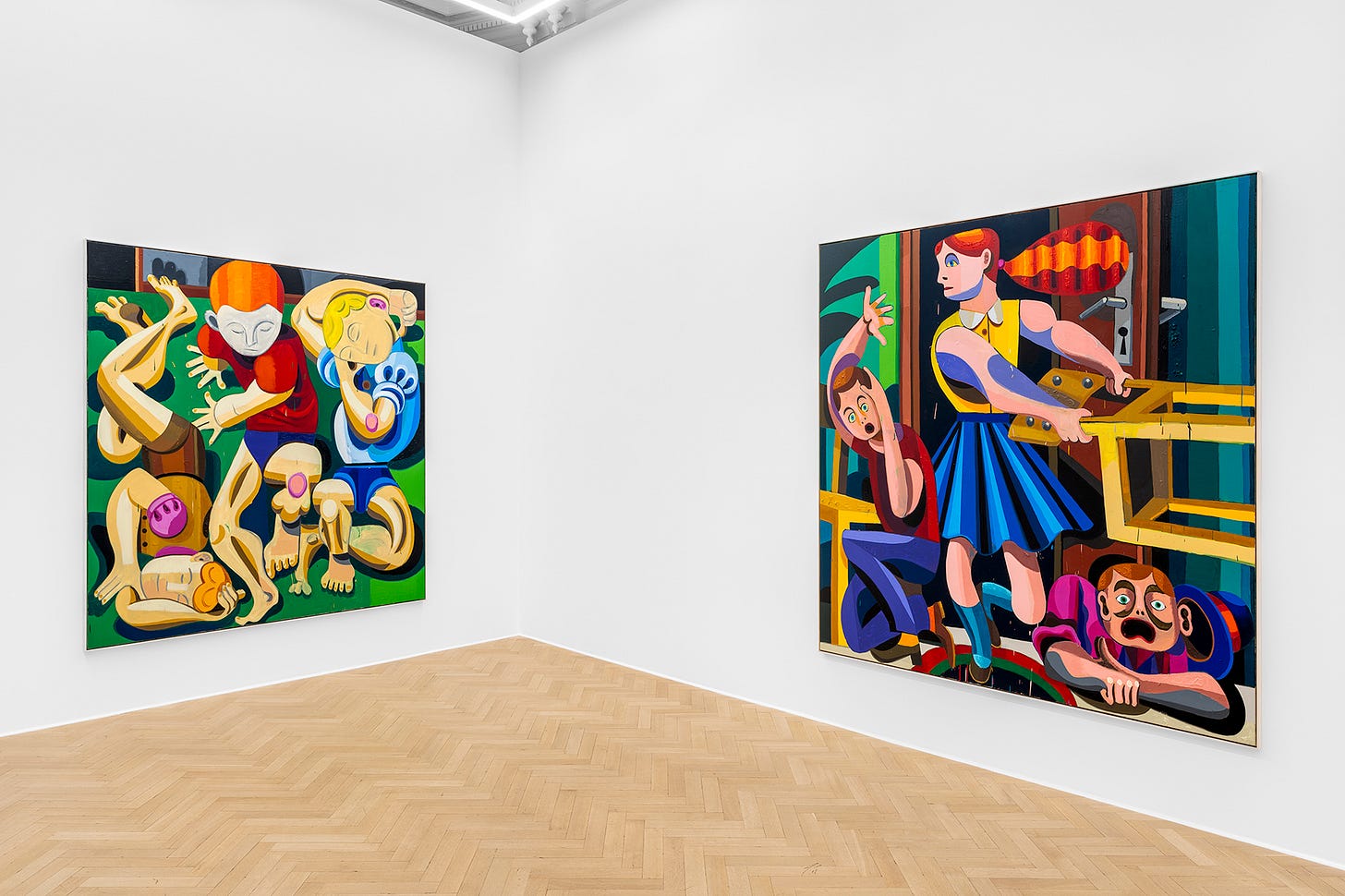
Christoph uses particularly harsh gradients in between hues. I kept thinking what it reminded me of. Sculptures? No. Woodcut prints? Kinda, but not really. Murals? Warmer. And then I found it: Sgraffiti!
A sgraffito is a three-dimensional mural created by layering plaster on a building facade and scratching parts away, revealing the colorful coatings underneath. They were historically widespread across Europe and had a revival in post-war city design. I found this example of a folkloric sgraffito in Oberösterreich right here. The Soviet Union and the DDR had an especially fond relationship with sgraffiti, often incorporating socialist imagery in public spaces. In the West, folkloric motives were popular. Socialist and folkloric imagery merge in Christoph’s anatomical freestyle. The puppet-like bodies aren’t moving fluidly. They’re more like wooden chunks attached. Pinocchioesque once again, innit?
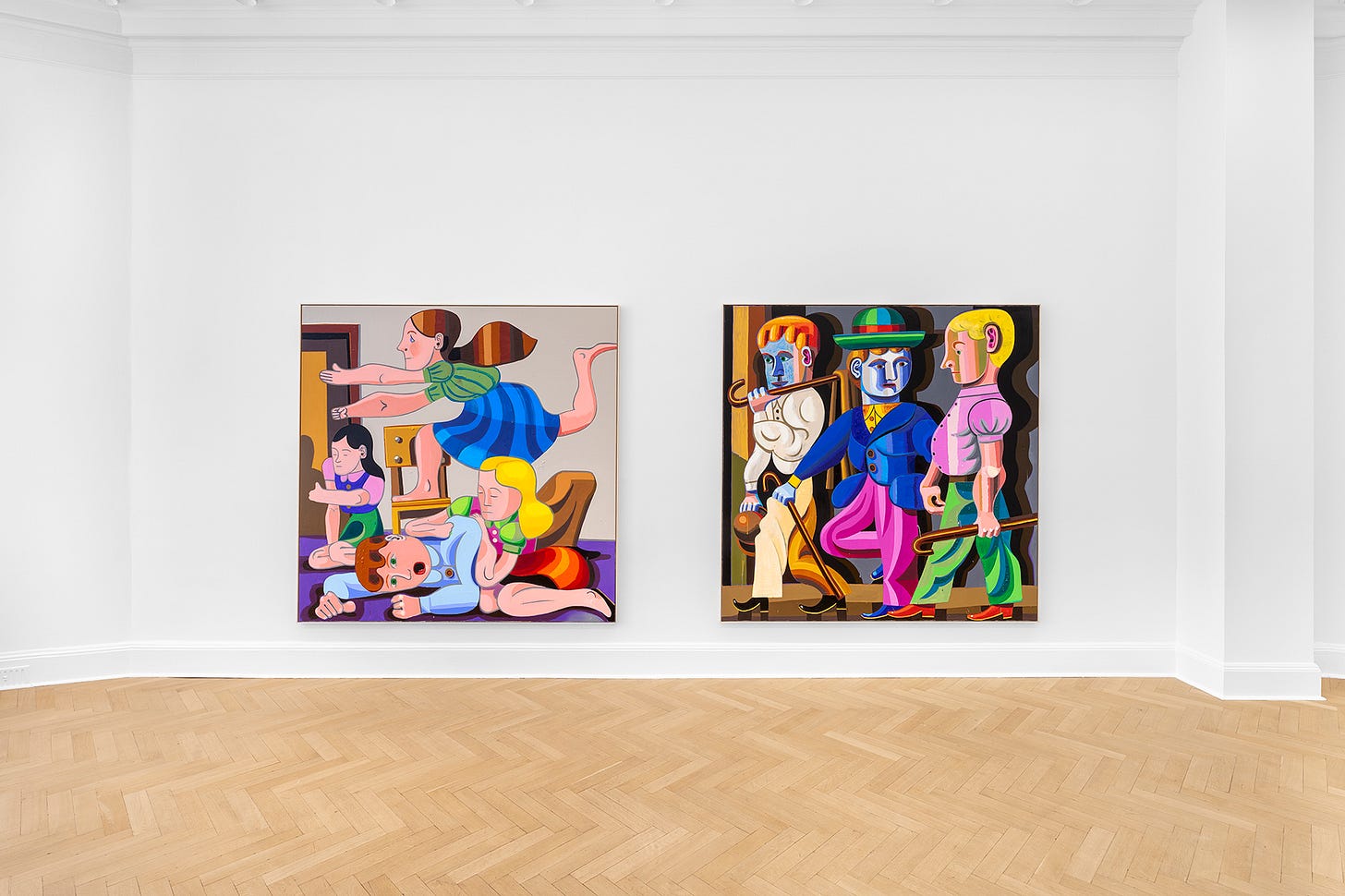
Speaking of fairytale figures, Christoph isn’t the only one working with folkloric stories and imagery. Artistically, Christoph and Paula Rego (1935-2022, British-Portuguese) would have been besties, R.I.P. Queen. Both go to the bottom of almost every fairytale: Violence. While Paula focuses on the psychologically disturbing nuances of well-known fairytales, Christoph manages to put the violence under a spotlight and yet make it invisible. This is what fairytales usually do: You start with a violent core story and make it entertaining over time. Adding more color and decorum and funny details so that a jolly egg dying cause gravity didn’t come to play isn’t shocking anymore because somebody put that shit into rhymes. And that one step-sister in Cinderella cutting off her heels to fit into a shoe isn’t registered in the memory of your kid-size brain that already has a shiny gem shoe to cater to.
So although Christoph woke up and chose violence, he’s making it comical. Some scenes look like the substitute teacher went out to cry in the bathroom for a moment and the kids started throwing hands. One girlypop is swinging that chair like she’s qualifying for the WWE. One boy is on the floor, and another one screaming in agony.
The most disturbing part is the wall with the India ink drawings on paper. In between dancing and frolicking in the grass, Christoph sneaked in some concerning footage: Guys assaulting girls, escalating scuffle, a girl getting at a guy with a knife on top of the corpses she already took out before him, a woman whooping some naked kids’ asses with a bottle. It’s very much giving dysfunctional family.

Sorry We’re Closed, through November 2, 2024. Rue des Minimes, 39, 1000 Brussels
LE SOLEIL N'EXISTE PAS - LEO LUCCIONI
Looking at the frequency with which Léo (Millennial, French) uses junk food and specifically candy as his motive, I hope he won’t miss the chance to call a future exhibition Sugar Daddy. He’s all about that double entendre, cause all I see is bars. Candy bars dangling in the exhibition hall… Yeah, no (w)rapping career for me… [chirping cricket sounds].
Those hanging candy bars made out of leather are part of Léo’s Snack de frappe series, a wordplay merging the French boxing bag (Sac de frappe) and snack. These candy bar boxing bags allow you to let out all your frustration on them. As a kid, I couldn’t eat candy in moderate amounts. I used to develop an obsession with one specific product at a time that would keep me in a chokehold for like half a year and after that, I’d be disgusted to even look at it. So I did shiver looking at the Bounty bar.
I’m not 100% convinced of Léo’s approach, though. Léo copies the design of famous brands, he doesn’t alter anything. The concept makes the Snack de frappe works dangerously appealing for Tech Bro collectors who’d put those in their living room next to a KAWS (Gen X, American) or, even worse, a Joseph Klibansky (Millennial, South African) statue. But on the other hand… pop off, Léo, sell that bag and get that bag!
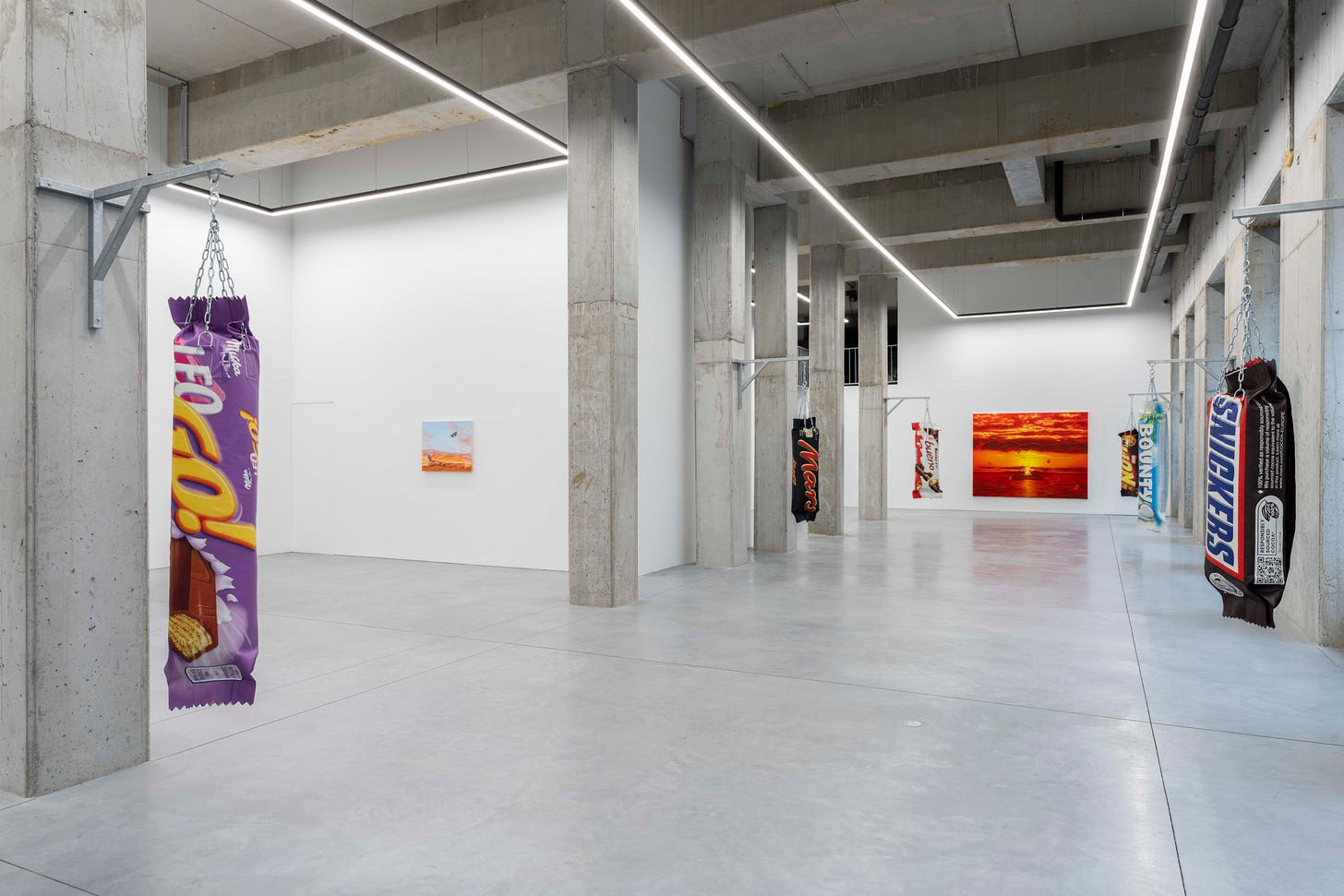
Consumerism lies at the core of Léo’s work. Not only is he interested in the stuff humans consume, but also the ideas. The theories, the conspiracies. Hence the provocative claim in his exhibition title: The sun? Doesn’t fucking exist.
A glaringly bright red painting at the very end of the exhibition hall promises to be the light at the end of the tunnel. Is it the sun? Still doesn’t exist. Coucher de soleil [Sunset] (2024) is a bonfire on a desolate island turning the whole horizon crimson red with its flames. That’s supposed to explain why sunsets usually turn red. The fire doesn’t seem to bother the butterflies swirling around against the blurry scene. This is such a Friedrich Kunath (Gen X, German) meets Albrecht/Wilke (both Millennial, German) move to pull.
The change in sky coloration is present in Léo’s smaller Nature morte ? paintings. Translatable as literally dead nature, the term means still life (the French do be a bit severe with it). And the small canvas size fits perfectly for still life painting.
Léo spray paints the base and adds the details on top. He doesn’t do a classical golden cut but pushes the ground to the lowest possible strip of the canvas, filling everything else with the sky. Candy and soft drinks lie in the sand. The sun is present only as lemon candy or the Caprisun logo. But the sun doesn’t exist anyway, remember?
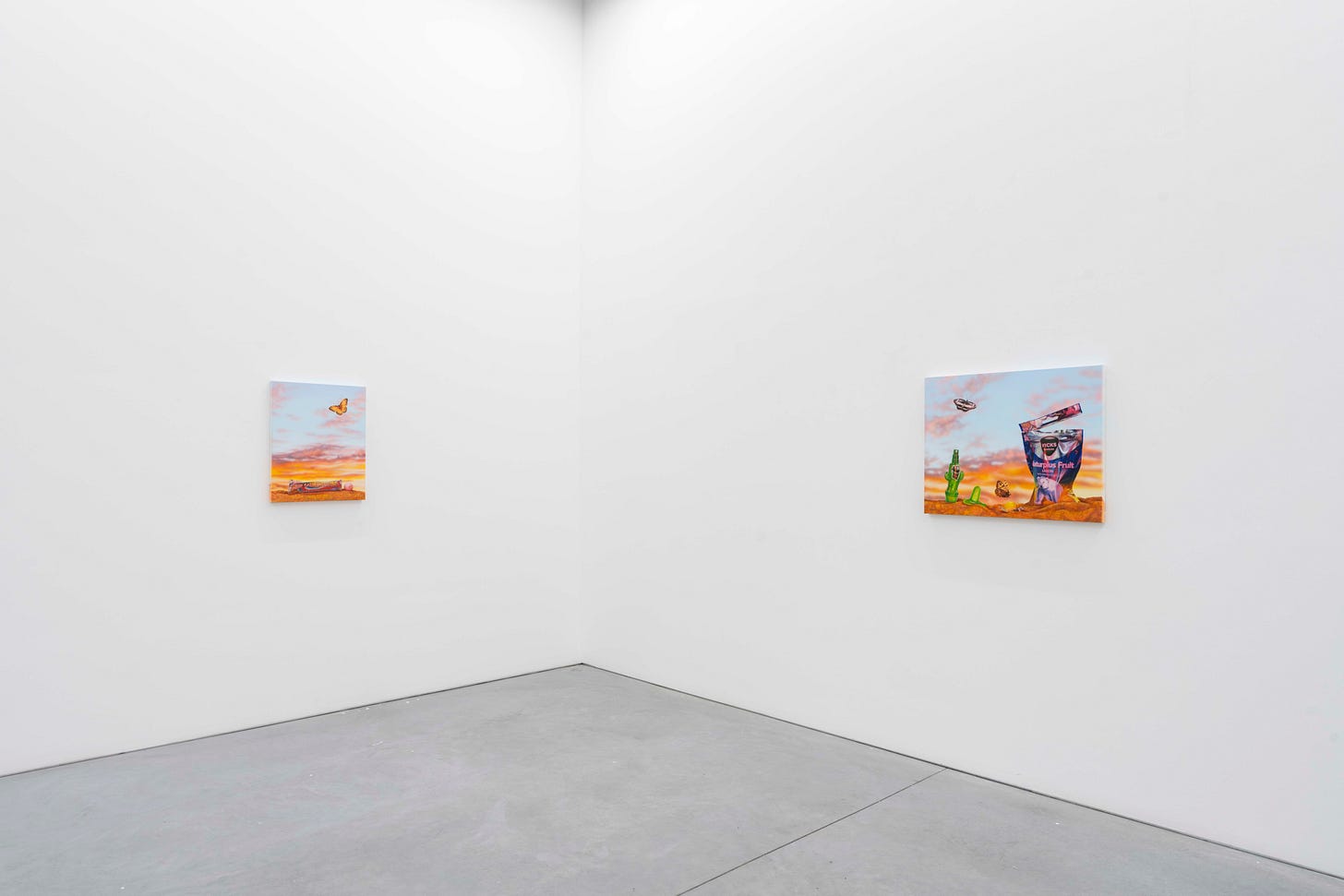
Léo points at climate change that, according to conspiracy theorists, doesn’t exist as well. Lying in the hot sunbathed sand you find Vicks menthol cough drops and Mr. Freeze icicles. Remember the simpler times when hearing freeze, you’d think of ice cream and playing tag outside instead of the London art fair?
Hopefully, those who left their stuff on that beach will return soon to pick it up. But what if they don’t? They can’t be far, I mean, somebody must have taken that pic in portrait mode. But what if they don’t come back? What if those candies and snacks are abandoned? What if these paintings picture a time (not too) far into the future when humans are no longer around? Will trash instead of monuments be all that remains? So is nature really dead? I guess we’ll never know. Butterflies gently swing their delicate wings and land on sweets. There might be hope. But I hope they won’t get trapped in the sticky sugar.
If this show had an official song, it would probably be Die With A Smile (2024). I bet Bruno Mars is Léo’s favorite singer… get it? Mars as in the candy bar? Because Léo makes work based on candy? [Taps mic] Is this thing on?
STEMS, through November 16, 2024. 4 Rue du Prince Albert, 1050 Brussels
Thank you for reading this review! If you liked this trip through Brussels, have a look at reviews I wrote on gallery shows in Antwerp last year.
Please consider becoming a paid or free subscriber to my blog to support my work. Subscribers can like and comment on my posts. And if you’re just checking things out, may I interest you in sharing this review with a friend at least?
See you soon!!!
Jennifer
The Gen Z Art Critic






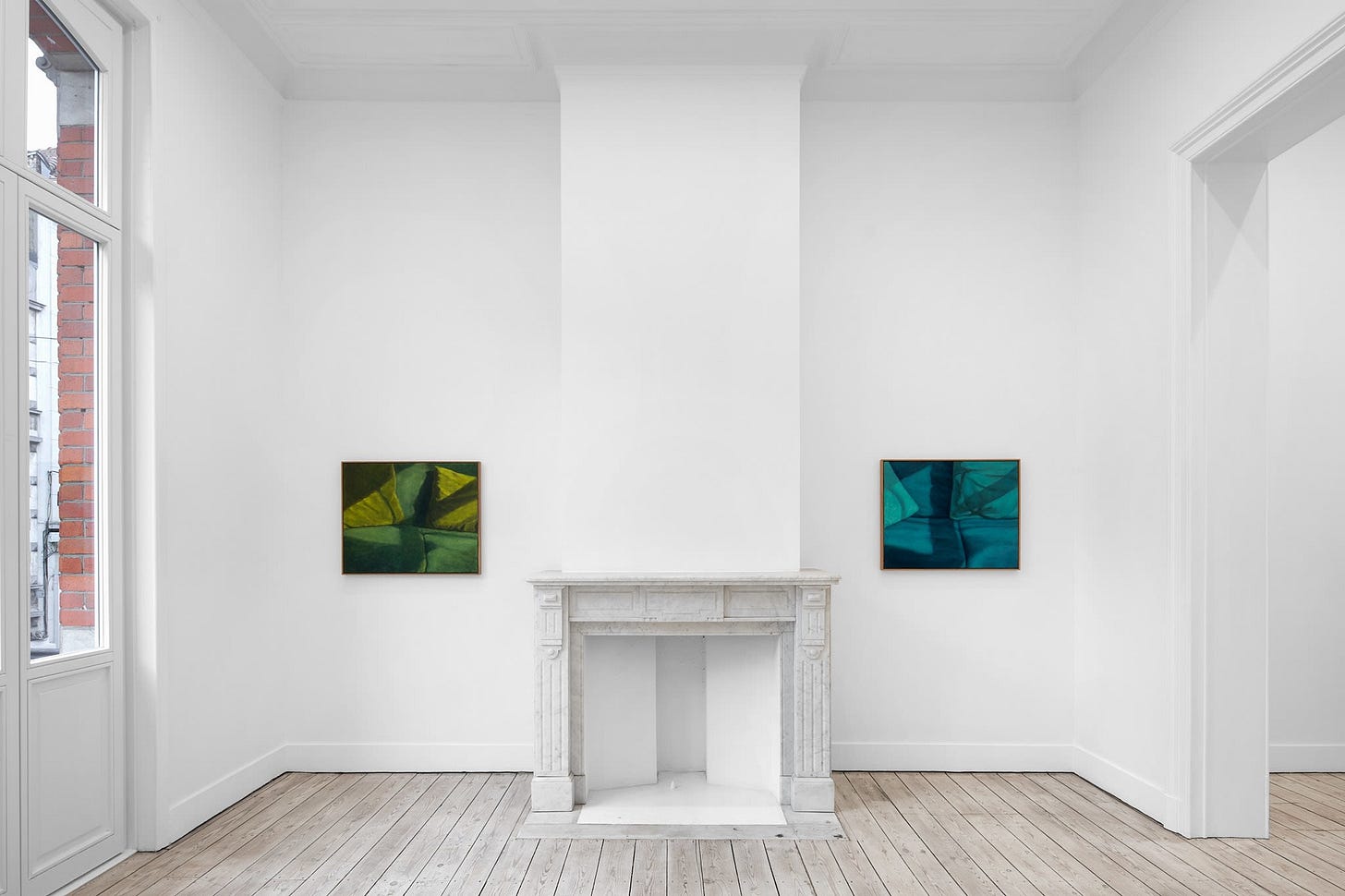
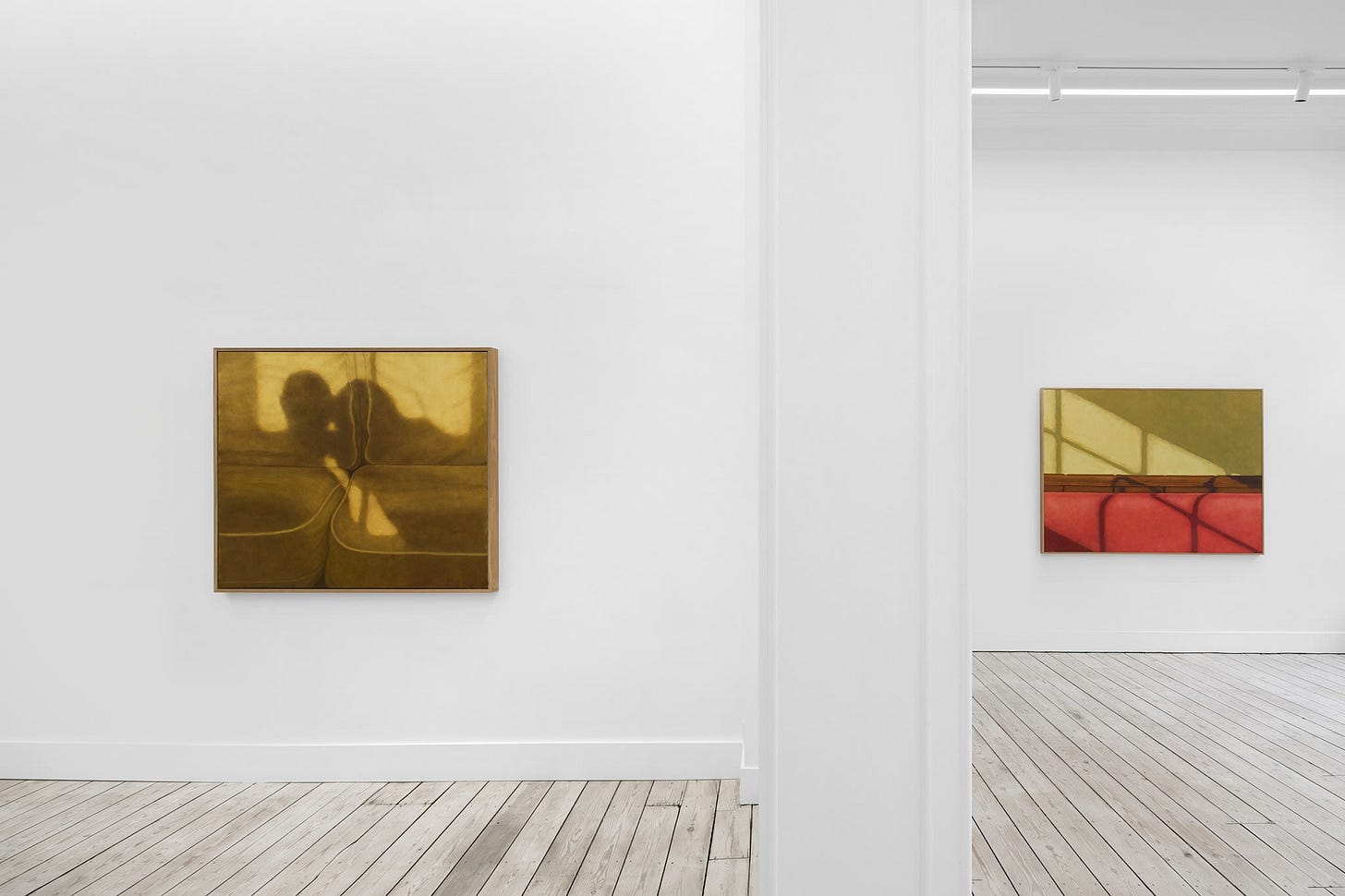
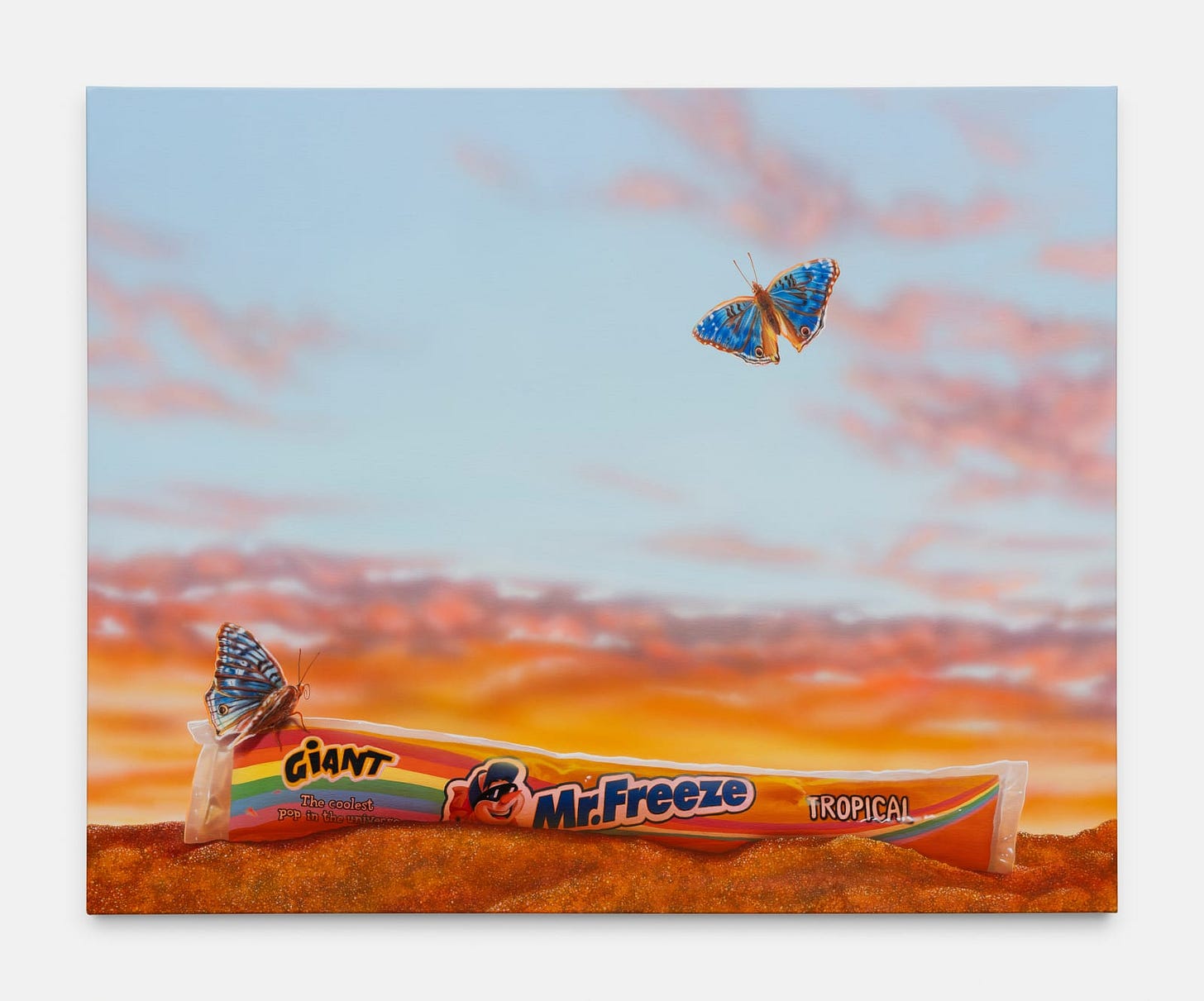
Regarding the Jess Allen review, I remember reading a quote from Edward Hopper in which he expressed his fascination with blank walls. If I can paraphrase it correctly, he said all he needed to be inspired was sunlight on a wall.